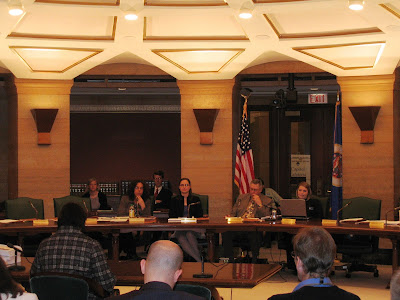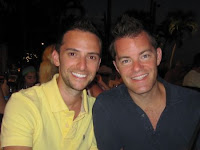
I was at the Minnesota Capitol on Friday for the Senate Judiciary Committee hearing on the Republican-introduced Constitutional Amendment bill that would ask the people of Minnesota to vote on placing discrimination in the State Constitution by prohibiting same-sex marriage in Minnesota.

I went to the Capitol as a Catholic gay man deeply opposed to any efforts to amend the Minnesota Constitution so as to ban marriage for same-sex couples. As such, I stand with the majority of Catholics in support of marriage equality for gay people. It's a stance that is inspired by the Gospel message of compassion and inclusion, and our Church's teaching on justice and human rights. I view efforts to pass the so-called “marriage amendment” as an assault on LGBT couples and families who simply want the same rights and protections that are available to all other Minnesotans. Equal protection of the law should apply to everyone – regardless of sexual orientation.
As many of those who testified against the proposed amendment at Friday's hearing noted, no family is "defended" and no one's life is improved when same-sex couples are denied the right to marry. Same-sex marriage harms no one, but would benefit thousands of LGBT Minnesotans and their children.
In addition, the amendment will, as OutFront Minnesota's executive director Monica Meyer says, "create a multi-million dollar political battle that will divide our communities and sideline the real issues that deeply affect all Minnesotans like the budget, education, jobs and the economy, transportation, and our quality of life."

Despite the moving and heartfelt testimonies of those opposed to the amendment, the committee voted to advance Senator Warren Limmer's bill to place the rights of a minority group of Minnesotans to marry on the ballot in November 2012. The vote was disappointing, but not really unexpected, given the sizable anti-equality majority on the committee. Still, the supporters of fairness for LGBT Minnesotans, who outnumbered amendment proponents by over three-to-one, sent a strong message that increasing numbers of Minnesotans oppose these attacks on their LGBT family members, friends and neighbors.

Above and below: Members of the public filled an overflow room at the Capitol and watched proceeding of the hearing on video monitors.

Sen. Barb Goodwin, DFL-Columbia Heights was, for many of those gathered, a real hero of the day. At one point she remarked that even if it meant she would be voted out by her constituents, she would never vote "to put language of discrimination in the constitution."
"I could not live with myself," she said, adding, "And [to] those of you who claim to be good Christians, you need to think about what you are doing here." This was a pointed reference to the many religious folks, including Bishop John Quinn of Winona, who spoke in favor of the amendment.
Sen. John Harrington, DFL-St. Paul, also drew thunderous applause from those in the overflow room – applause audible in the senate hearing room – when he said that the measure did nothing to support the principles the nation was founded on.
"I cannot see in this bill anything that promotes life, anything that promotes liberty," he said. "If anything, it seems to restrict liberty. I cannot see anything that will promote the pursuit of happiness. It sends a chilling message that it is OK to discriminate. It sends the message that gays in Minnesota are ‘less than.’"

In the wake of the senate committee vote to place the marriage amendment on the 2012 ballot, a number of powerful commentaries and op-eds have been written and published.
I close this post with links to many of these and with David Schultz's commentary Constitutional Prejudice: Why the Minnesota Senators Got it Wrong on Same-Sex Marriages, reprinted in its entirety. Schultz is a Professor in the School of Business at Hamline University, St. Paul, MN.
No surprise – Minnesota Senate Republicans unveiled on April 26, a state constitutional amendment to bar same-sex marriage. Assuming it clears the legislature and goes to the voters there is no guarantee that it will pass. But that is beside the point. The purpose of the amendment is less about its actual passage than about symbolic politics and voter mobilization in the 2012 elections. Its proposal demonstrates a gross misunderstanding of American politics, the Constitution, and is an unfortunate and cynical appeal to prejudice for political gain.
Why a constitutional amendment to bar same-sex marriage? It seems unnecessary given a 1971 Minnesota Supreme Court decision Baker v. Nelson and a 1997 state law barring same-sex couples from marrying. Yet GOP Senators in affirming their reasons for the amendment stated that laws can change and courts can alter their minds but constitutional amendments are more permanent. They contended that voters have a right to have a say on who is allowed to marry.
The senators are correct about the former, wrong about the latter. However, the law should change to reflect new circumstances and public opinion and judges should calibrate interpretations in light of new facts and circumstances. The law should not be fixed in the past reflecting old prejudices and beliefs. To argue that is to assert that the law should be frozen in the past. Democracy is about consent of the present, not of the past.
But the law should not be fixed in the past. Such logic was characteristic of the most notorious Supreme Court case of all time – Dred Scot v. Sanford – an 1854 decision declaring African-Americans (then slaves) could never be citizens because it was contrary to the intent of the constitutional framers. The same logic persistent in the 1874 Minor v. Happersett case where the Supreme Court ruled that women could not vote for similar reasons. These decisions reaffirmed old prejudices and beliefs. The purpose of the law should not be to enshrine dogmas and prejudices. The Supreme Court said the same in its 1967 Loving v. Virginia decision striking down a Virginia law barring couples of different races from marrying. In Loving the Court declared marriage a fundamental right–the essence of a free society is letting people decide with whom they form a life.
Democracy is about majority rule, but such a decision about who we can marry is not a choice for majorities to decide. This is why we have a Bill of Rights – to protect the minority from the tyranny of the majority.
As Justice Jackson eloquently declared in a case affirming freedom of religion: “The very purpose of a Bill of Rights was to withdraw certain subjects from the vicissitudes of political controversy, to place them beyond the reach of majorities and officials and to establish them as legal principles to be applied by the courts. One’s right to . . . freedom of worship . . . and other fundamental rights may not be submitted to vote; they depend on the outcome of no elections.” The same is true with marriage. I doubt anyone believes that the voters should have been able to decide in 1967 or today whether individuals of different races should marry. Proposals to put this to a vote simply mask racism and appeal to prejudice. The same logic applies to same-sex marriage.
There is no good public policy reason to bar same-sex couples from marrying. But the constitutional amendment is not about policy, it is about symbolic politics and voter mobilization. As was demonstrated in 2004 when Karl Rove and the GOP placed bans on same-sex marriage on the ballots across many states, it was a terrific hot button issue to mobilize voters. It worked. The religious conservatives turned out in droves.
Placing a ban on gay marriage on the ballot for 2012 might work for similar purposes. First, it is a symbolic payback to the religious right who backed GOP candidates in 2010. Thus, it is pandering to special interests. Second, placing the amendment on the ballot is simply an effort to repeat 2004. The hope no doubt is that this amendment in 2012 will offset what some think will be a better year for Minnesota Democrats when Barack Obama and Amy Klobuchar are on the ballot. Place this amendment on the ballot and as the theory goes, it will drive more conservatives to vote.
However, 2012 is not 2004 and such a strategy may backfire as public opinion has changed and it may engage progressives this time. This is a gamble the GOP senators are taking. Their purpose thus is not so much to pass the amendment but use it and cynically appeal to prejudice to pay off supporters and drive voter turnout.
Recommended Off-site Links:
Senate Committee Passes Anti–Gay Marriage Amendment -- Andy Birkey (Minnesota Independent, April 28, 2011).
With GOP in Control of Legislature, Gay Marriage Ban Approved by MN Senate Committee -- Patrick Condon (Associated Press via the Star Tribune, April 29, 2011).
MN Legislators' Triming of Marriage Amendment Wording Could Leave Door Open for Same-Sex Civil Unions -- Rachel E. Stassen-Berger (Star Tribune, April 28, 2011).
A Tipping Point for Gay Marriage? -- Adam Liptak (New York Times, April 30, 2011).
Supporter of Gay Marriage Offers Sunny View of Vote -- Gail Rosenblum (Star Tribune, April 30, 2011).
Just Say No to Wedge Politics -- Lori Sturdevant (Star Tribune, April 30, 2011).
Banning Gay Marriage Would Institutionalize Injustice -- Gary Boelhower (Duluth News Tribune, May 1, 2011).
See also the previous Wild Reed posts:
Quote of the Day – April 21, 2011
Governor Mark Dayton to LGBT Advocates: "I Stand with You"
A Celebration of Faith and Family; A Call for Compassion and Fairness
Quote of the Day – November 4, 2010
A Message for NOM (and the Catholic Hierarchy
Minnesotans Rally for Equality and Love
Responding to Bishop Tobin's Remarks on Gay Marriage
Archbishop Nienstedt Calls (Again) for a Marriage Amendment to Minnesota's Constitution
A Catholic Statement of Support for Same-Sex Marriage
Steve Chapman: "Time is On the Side of Gay Marriage
Dale Carpenter on the Win-Win" Reality of Gay Marriage
Dr. Erik Steele on the "Naked Truth on Same-Sex Marriage
Stephanie Coontz on the Changing Face of "Traditional Marriage"


















































